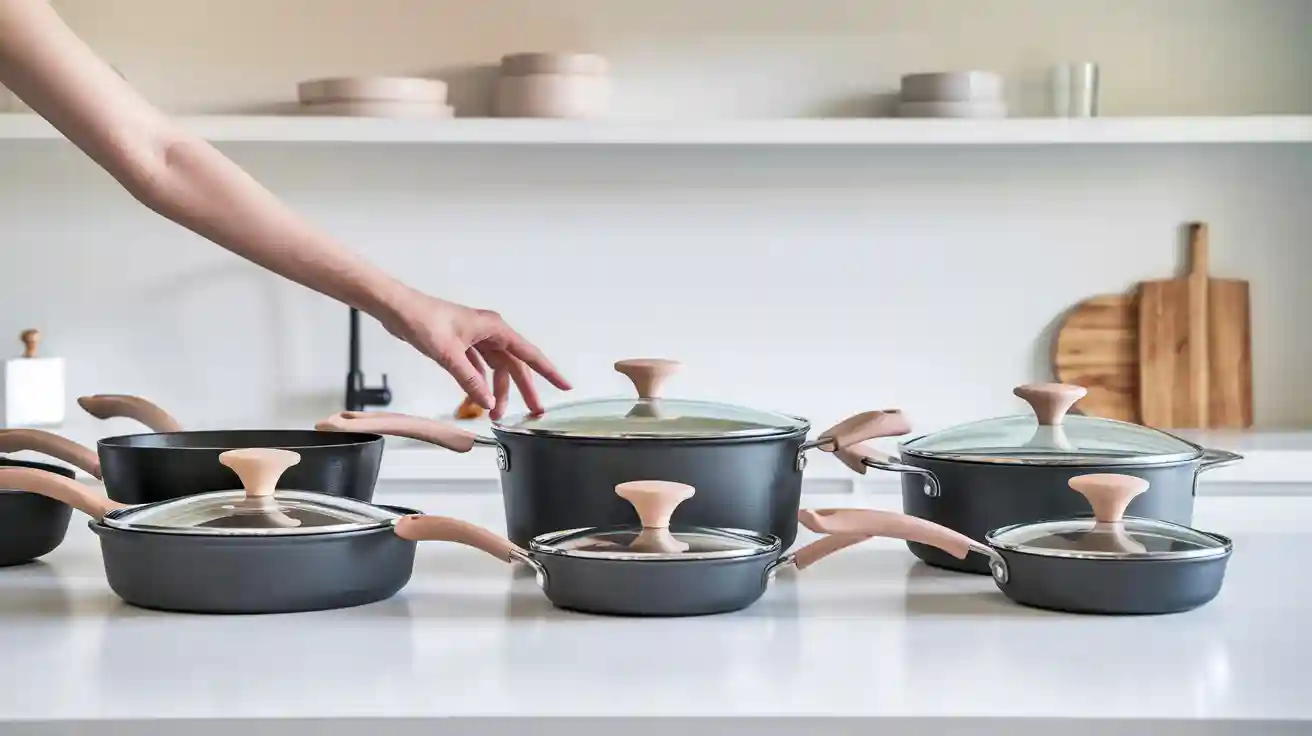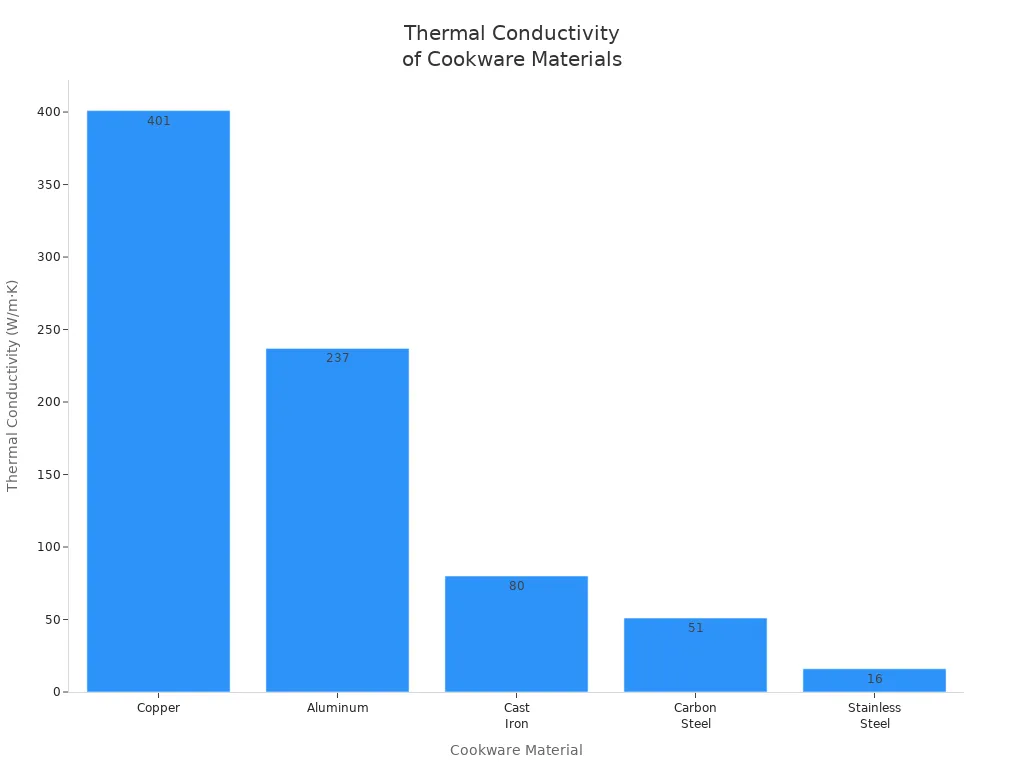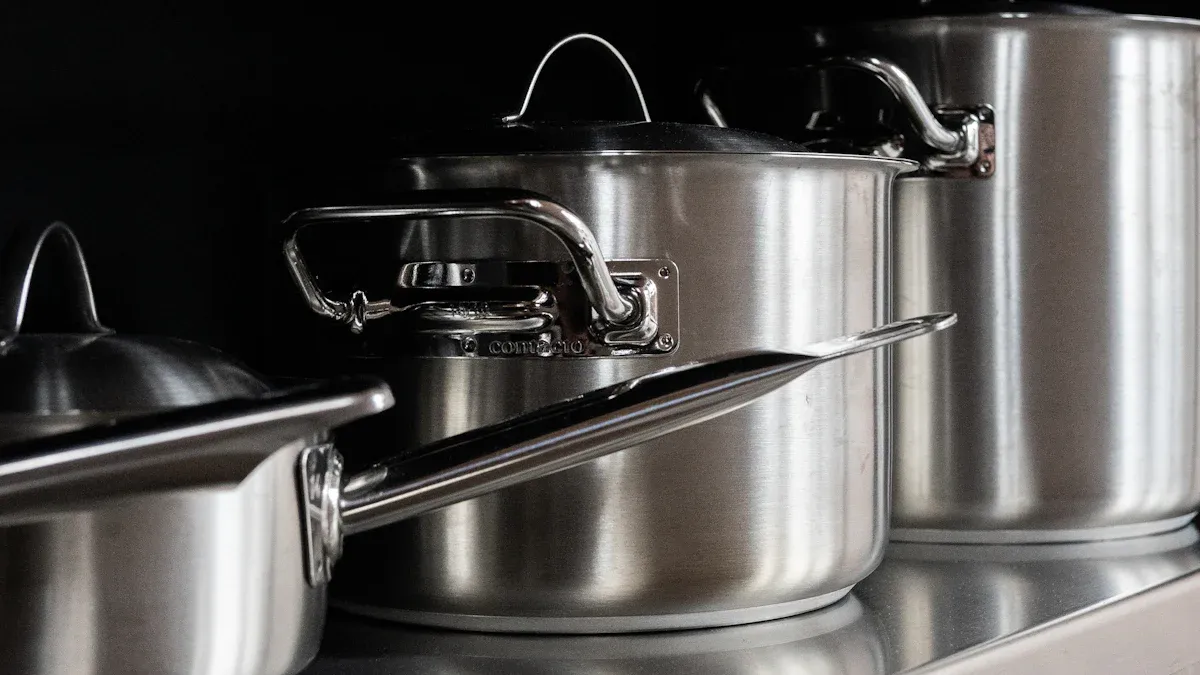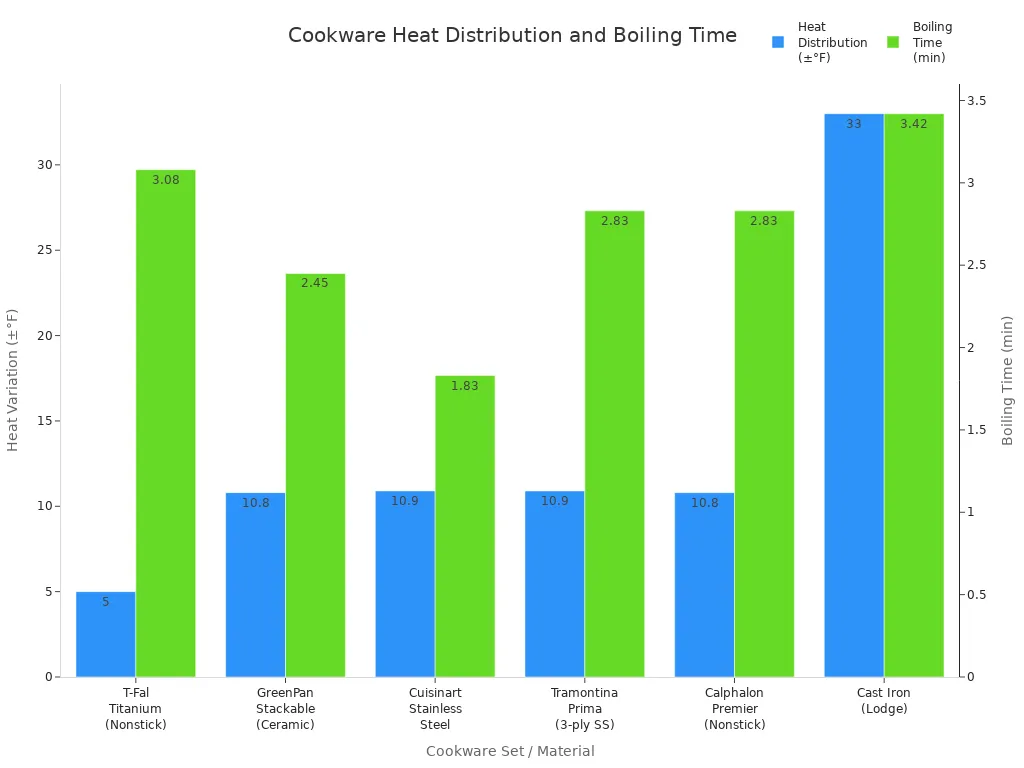
When you start buying a cookware set, you want the perfect cookware set that fits your cooking style and kitchen. Many people look for high-quality cookware that lasts, cooks evenly, and feels easy to clean. You might weigh factors to consider like price, safety, and even how the best cookware set looks in your space.
- Convenience and affordability matter to most shoppers.
- Compact, multifunctional cookware works well for smaller kitchens.
- Health, safety, and eco-friendly choices are growing in popularity.
Cookware Buying Guide: Understanding Materials
When you start your cookware buying guide, understanding cookware materials is the first step. Each type of cookware has its own strengths and weaknesses. Let’s break down the most popular options so you can pick what fits your kitchen best.
Stainless Steel
You see stainless steel in many kitchens. It leads the U.S. market because it lasts a long time, resists rust, and works on almost any cooktop. Stainless steel cookware heats up quickly and handles high temperatures well. Many people like it for its durability and even cooking. You might need to use oil or butter to keep food from sticking, and cleaning can take some effort, but it often goes in the dishwasher.
Nonstick
Nonstick cookware makes cooking and cleaning easy. Food slides right off, so you can cook eggs or pancakes with little mess. Nonstick surfaces work well for low-fat cooking. However, these pans do not last as long as others. The coating can scratch or wear out, and some people worry about chemicals in older nonstick surfaces. If you want a safer choice, look for ceramic-coated pans.
Tip: Replace nonstick cookware if you see scratches or the coating starts to peel.
Cast Iron
Cast iron cookware holds heat better than almost any other material. It’s perfect for slow cooking and searing meat. You need to season it with oil to keep it nonstick and prevent rust. Some people find cast iron heavy and harder to clean, but it can last for generations if you care for it.
Copper
Copper cookware heats up fast and cools down quickly. Chefs love it for making sauces and delicate foods. You need to polish copper to keep it shiny, and it often comes lined with tin or stainless steel to stop food from reacting with the metal. Copper pans cost more and need more care, but they look beautiful and cook evenly.
Hard-Anodized Aluminum
Hard-anodized aluminum cookware is strong and safe. The special coating makes it tougher than regular aluminum and less likely to react with food. It often has a semi-nonstick surface, so cleanup is easier. This cookware lasts longer and resists scratches better than basic aluminum pans.
Carbon Steel
Carbon steel cookware is a favorite for both home cooks and chefs. It heats up fast, handles high temperatures, and is lighter than cast iron. With seasoning, it develops natural nonstick surfaces. You need to dry and oil it after washing to prevent rust. Carbon steel pans work well for frying, sautéing, and even baking.
Understanding cookware materials helps you choose the right set for your needs. Each type offers something special, so think about what matters most to you in the kitchen.
Best Cookware Material: Pros and Cons
Heat Conductivity and Retention
When you want food to cook evenly, you need cookware that heats up fast and holds heat well. Copper stands out for its amazing heat conductivity. It heats up quickly and cools down just as fast, which helps you control the temperature. Aluminum also conducts heat well and feels light in your hand, but it does not hold heat as long as copper or cast iron. Cast iron heats up slowly, but once it gets hot, it stays hot for a long time. This makes it great for searing meat or slow-cooking stews. Stainless steel does not conduct heat as well, so many brands add a copper or aluminum core to improve performance. Here’s a quick look at how different cookware materials compare:

Durability and Maintenance
You want your cookware to last. Stainless steel can last for decades with normal use. Cast iron and carbon steel can last a lifetime if you take care of them. Copper also lasts a long time, but you may need to reline it every few decades if it has a tin lining. Nonstick pans usually last two to five years, depending on quality and care. Ceramic cookware often lasts less than five years. Here’s a table to help you compare:
| Cookware Material | Average Lifespan | Maintenance Challenges |
|---|---|---|
| Stainless Steel | Decades | Can discolor, needs scrubbing |
| Cast Iron | Lifetime | Needs seasoning, can rust |
| Carbon Steel | Lifetime | Needs seasoning, can rust |
| Copper | Lifetime | Needs polishing, can tarnish |
| Nonstick | 2-10 years | Scratches easily, coating can peel |
| Ceramic | <5 years | Can chip or crack |
Tip: Always follow the care instructions for your cookware to get the most years out of it.
Safety and Non-Toxicity
You want the best cookware material for your health. Stainless steel, cast iron, carbon steel, glass, and 100% ceramic are all safe choices. These materials do not have harmful chemicals like PFAS, PFOA, or PTFE. Cast iron and carbon steel can even add a little iron to your food, which is good for you. Avoid unlined copper and plastic cookware, as they can be unsafe. Look for cookware with safety certifications like FDA approval or Prop 65 compliance. Brands like Lodge, Made In, and Greenpan offer safe, non-toxic options.
- Safe materials: stainless steel, cast iron, carbon steel, glass, ceramic (lead-free)
- Avoid: unlined copper, plastic, nonstick with PFOA or PTFE
Choosing the best cookware material means thinking about how it cooks, how long it lasts, and how safe it is for your family.
Buying the Best Pot and Pan Set: Choosing the Right Pieces

Essential Pots and Pans
When you start buying the best pot and pan set, you want to cover your daily cooking needs. Culinary experts suggest these must-have pieces for any kitchen:
- A 10-inch frying pan for searing meats and sautéing veggies.
- A 3-quart sauté pan with a lid for one-pan meals and family dinners.
- A 2-quart saucepan with a tight lid for sauces and grains.
- An 8-quart stockpot for soups, pasta, and broths.
- A 12-inch nonstick frying pan for pancakes or bigger meals.
- A 5-quart Dutch oven for stews, baking bread, or serving salads.
Look for cookware made from sturdy materials like stainless steel or quality nonstick. Comfortable handles and even heating are features to look for in the best cookware set.
Specialty Items
You might want to add specialty cookware for more cooking options. Here’s a quick guide to what you’ll find in professional kitchens:
| Cookware Item | Typical Uses and Characteristics |
|---|---|
| Skillets | Frying, sautéing, searing |
| Saute Pans | Cooking with more liquid, less movement |
| Saucier Pans | Easy stirring and whisking |
| Woks | Stir frying, deep frying, steaming |
| Stock Pots | Stocks, sauces, pasta |
| Roasting Pans | Roasting meats or poultry |
| Braziers | Slow cooking, juicy results |
Set Sizes and What to Look For
Comparing top-rated cookware sets helps you find the right fit. Sets come in different sizes and types of cookware. Here’s what you can expect:
| Cookware Type | Typical Sizes | Usual Inclusions / Uses |
|---|---|---|
| Stock Pots | 8 Qt, 16 Qt | Pasta, soups, chili, broths |
| Saucepans | 1 Qt, 2 Qt, 3 Qt | Sauces, rice, reheating, boiling |
| Dutch Ovens | Various | Stews, roasts, casseroles, braised meats |
| Fry Pans | 10″-12″ | Sautéing, frying, searing |
| Sauté Pans | 4 Qt | Sautéing, simmering, searing |
| Woks | 12″ | Stir fry, Asian recipes |
| Sauciers | 1 Qt | Sauces, whisking, stirring |
| Braisers | 2.25 Qt, 5 Qt | Braising, simmering, risotto |
| Roasting Pans | Various | Roasting meats, casseroles, pasta bakes |
When comparing top-rated cookware sets, check for features to look for like sturdy lids, oven safety, and easy cleaning. The best cookware set will match your cooking style and kitchen space. Buying the best pot and pan set means you get the right types of cookware for your needs.
Evaluating the Best Cookware Set for Performance
Heat Distribution and Cooking Results
When you start evaluating cookware performance, you want to know how well each set cooks your food. Some cookware heats up fast and spreads heat evenly, while others have hot spots. If you want the best cookware set, look for even heat distribution and good cooking results. Take a look at this table from product reviews:
| Cookware Set / Material | Heat Distribution | Stickiness Performance | Boiling Time | Searing Ability |
|---|---|---|---|---|
| T-Fal Titanium (Nonstick) | Very even (~±5 °F) | Least sticky, easy release | 3:05 min | Best among nonstick |
| GreenPan Stackable (Ceramic) | Good (~±10.8 °F) | Slight stickiness, easy clean | 2:27 min | Top ceramic nonstick |
| Cuisinart Stainless Steel | Good (~±10.9 °F) | Needs pre-heating, no stick | 1:50 min | Good searing |
| Tramontina Prima (3-ply SS) | Good, well regulated | Minimal sticking with oil | 2:50 min | Top non-cast iron searing |
| Calphalon Premier (Nonstick) | Good, thick layers | Durable, less sticky | 2:50 min | Strong searing |
| Cast Iron (Lodge, Amazon Basics) | Uneven, up to 33 °F | Needs seasoning, effective | 3:25-9:10 min | Best searing, crispiest results |

Nonstick cookware with aluminum cores gives you the most even heat. Cast iron gives you the best searing, but you need to watch for uneven heat. Stainless steel works well if you preheat it and use oil or butter.
Handles, Lids, and Design Features
When evaluating cookware performance, you should pay attention to comfort and design. The best cookware set feels good in your hand and makes cooking easier. Here are features that many people love:
- Stay-cool, comfortable handles help you move pans safely.
- Balanced weight makes cookware easy to lift and pour.
- Glass lids let you see your food without lifting the lid.
- Sets with frying pans, saucepans, and stockpots give you more options.
- Lightweight ceramic cookware is easy to handle.
- Extras like storage racks or steamer inserts add value.
Combining stainless steel and nonstick pans gives you more flexibility in the kitchen.
Ease of Cleaning
Ease of cleaning and maintenance matters when you choose cookware. Nonstick pans clean up fast with just a wipe. Stainless steel and cast iron need a bit more work, but you can keep them looking great with the right care. If you want the best cookware set for ease of cleaning and maintenance, look for dishwasher-safe options and smooth surfaces. Lightweight pans also make washing up easier. When evaluating cookware performance, always think about how much time you want to spend cleaning after you cook.
Matching the Perfect Cookware Set to Your Needs
Cooking Style and Habits
Your cooking style shapes the cookware you need. If you love quick stir-fries or searing steaks, you might reach for carbon steel or cast iron. These materials heat up fast and handle high temperatures well. If you prefer slow-cooked stews or braised dishes, enameled cast iron or stainless steel pots work best. Many home cooks who focus on healthy meals like steaming or boiling choose stainless steel. It supports cooking with less oil and keeps flavors pure.
Take a look at how different cookware materials fit various cooking habits:
| Cookware Material | Cooking Style Influence | Pros & Cons Summary |
|---|---|---|
| Copper | Great for precise temperature control; ideal for sautéing, boiling, simmering | Needs polishing; expensive; not for induction |
| Cast Iron | Perfect for high-heat cooking and oven use | Durable; heavy; needs seasoning |
| Enameled Cast Iron | Versatile for slow cooking, braising, roasting | Easy to clean; heavy; dishwasher safe |
| Carbon Steel | Fast heating; good for multi-purpose cooking | Lighter than cast iron; needs seasoning |
| Nonstick | Easy to clean; best for low-fat, gentle cooking | Not for high heat; coating can wear out |
You might also want to match your cookware to your favorite recipes. Skillets work well for sautéing, while Dutch ovens shine for baking and stews. If you often cook acidic foods like tomato sauce, enameled cast iron or stainless steel will not react with your ingredients. Your daily habits and favorite dishes are important factors to consider when building your set.
Tip: If you want cookware that lasts, choose cast iron or stainless steel. These can serve you for generations with the right care.
Cooktop Compatibility
Your cooktop matters when picking cookware. Not every pot or pan works on every stove. Induction cooktops need cookware with a magnetic base. Cast iron, enameled cast iron, and many stainless steel pans work well on induction. If you have a gas stove, you can use almost any cookware. Stainless steel and copper give you even heat on gas burners. Electric stoves with glass tops need flat-bottomed cookware for good contact. Heavy-duty aluminum and stainless steel are good choices here.
Here’s a quick guide to help you match cookware to your cooktop:
| Cooktop Type | Compatible Cookware Materials | Notes |
|---|---|---|
| Induction | Cast iron, enameled cast iron, magnetic stainless steel | Use a magnet to check compatibility |
| Gas | Most materials: stainless steel, copper, cast iron, aluminum | Even heat distribution is key |
| Electric (glass) | Stainless steel, heavy-duty aluminum, flat-bottomed cookware | Flat bottoms prevent wobbling and heat loss |
To check if your pan works on induction, hold a magnet to the bottom. If it sticks, you are good to go. Some nonstick pans also work on induction if they have a magnetic layer. Always match your cookware to your stove for the best results.
Budget Considerations
Your budget plays a big role in your cookware choices. High-quality cookware sets can cost between $700 and $900 in 2024, especially for brands like All-Clad or Hestan. These sets offer great durability and performance. If you want to save money, you can find budget-friendly sets under $200, but they may not last as long or cook as evenly.
Here’s a table to help you see how different materials fit different budgets:
| Cookware Material | Cost Considerations | Durability & Maintenance | Budget Impact |
|---|---|---|---|
| Copper | Expensive | Needs polishing, high maintenance | Premium choice for performance |
| Aluminum | Inexpensive | Lightweight, may react with acids | Good for budget-friendly sets |
| Carbon Steel | Affordable | Needs seasoning, versatile | Great value, needs care |
| Cast Iron | Less expensive | Heavy, needs seasoning | Durable, economical |
| Stainless Steel | Varies | Durable, low maintenance | Options for every budget |
| Nonstick | Varies | Coating wears out | Lower cost, may need replacing |
When you shop, think about your cooking needs and how much you want to spend. Stainless steel offers options for every budget. Aluminum and carbon steel give you good value if you do not mind a little extra care. Copper costs more but gives you top performance if you love to cook. Always balance price, durability, and your own needs before you buy.
Note: Investing in one or two high-quality pieces can be smarter than buying a large set that does not fit your cooking style.
Care and Maintenance for Long-Lasting Cookware
Cleaning Best Practices
Taking care of your cookware keeps it looking new and working well. Each type needs a little something different. Here’s a quick guide to help you clean your pots and pans the right way:
| Cookware Type | How to Clean | Special Tips |
|---|---|---|
| Stainless Steel | Hand wash or use dishwasher. For stains, boil cream of tartar and water. | Skip harsh abrasives. |
| Cast Iron | Wash with hot water and a stiff brush. No soap. Use salt for stuck food. | Dry right away to prevent rust. |
| Enamel Cast Iron | Use warm soapy water and a soft cloth. | No abrasives. |
| Nonstick | Gently hand wash with dish soap and a soft sponge. | Never use the dishwasher. |
| Ceramic | Hand wash with soft cloth and soapy water. | Vinegar soak helps with stuck food. |
| Aluminum | Anodized: dishwasher safe. Non-anodized: hand wash. | Baking soda removes stains. |
| Copper | Wash with hot soapy water. Polish with lemon and salt. | No dishwasher. |
| Carbon Steel | Wash with hot water and a sponge. No soap. Use salt for tough spots. | Dry after cleaning. |
Tip: Clean your cookware while it’s still warm. This makes it easier to remove food and keeps your pans in top shape.
Storage and Longevity
How you store your cookware matters just as much as how you clean it. You want to keep your pots and pans scratch-free and ready to use. Try these simple storage tips:
- Place felt rounds, dishcloths, or silicone pads between stacked pans to stop scratches.
- Never stack nonstick pans without a liner. This keeps the coating safe.
- Store enameled cast iron in a dry spot. Keep lids off or right-side up to avoid moisture.
- Let pans cool before washing to prevent warping.
- Dry all cookware completely before putting it away. This helps stop rust and water spots.
- Check your cookware often for dents, loose handles, or scratches. Fix problems early to make your set last longer.
When you follow these steps, you boost the ease of cleaning and maintenance for your cookware. Good habits help your favorite pots and pans last for years.
When you choose your cookware set, focus on what matters most:
- Safety comes first. Stainless steel and glass are top picks for peace of mind.
- Your needs and habits shape the best choice.
- High-quality cookware costs more upfront but saves you money and hassle over time. You get better results and enjoy cooking more.
FAQ
What is the best cookware set for beginners?
You should start with a stainless steel or nonstick set. These are easy to use, clean, and fit most cooking styles.
Can I use metal utensils on nonstick pans?
No, you should use wooden or silicone utensils. Metal can scratch the nonstick coating and make your pans wear out faster.
How do I know if my cookware works on induction cooktops?
Just grab a magnet and stick it to the bottom of your pan. If it sticks, your cookware will work on induction stoves.


